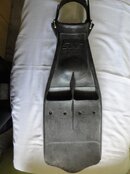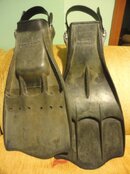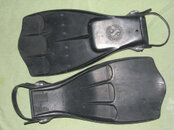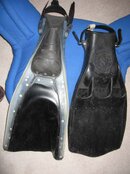I wasn't going to post on this thread about Freediving fin superiority over Jet, until I saw so many posts claiming that jets are the best fin there is....
The truth, which is easy to demonstrate, is that the jets are very inefficient fins compared to the vastly superior technologies of carbon fiber or composite freedive fins....which can allow a kick and glide to use either half the effort, or double the glide between kicks.....roughly.
And then so many will say, fine, but I wont use freediving fins, they are too big on the boat, etc., etc.... And in truth, if you are doing penetration diving with a close/tight overhead ceiling the fin tips could scrape, then the freedive fins are the wrong fins......BUT...there is still a choice for a fin actually slightly shorter than Jets, with FAR MORE advanced technology and efficiency...and this is Force Fins....Specifically, the Extra Force or the Excellerating Force models are the ones I would put up against the Jets....
In this contest, there is one area the jets will win in....If you are having a race on the bottom, over a muck bottom and you need to be close to the bottom...you need to frogkick...then the slightly larger blade of the jet fin, as stiff as it is, will push a little more water per kick cycle...per push, than the Extra Force or the Excellerating Force--because the blade areas are not quite as large....However, most of the divers I know that choose to do frogkick all the time, don't want to race, so the speed difference here is really moot for most divers...and over muck bottoms, high speed is not usually on the agenda--precision and no silting, is--and the Force fins shine much brighter here than do the jets......
And....When speed is important....when you have to go upcurrent to an anchor line, or get to a buddy in an emergency, or get a video of a manta ray or whaleshark or other marine life that is swimming at 3 to 4 mph...the problem with the jets is that they are ok for flutter kick, only up to a certain effort level, and then they become very inefficient....Take even a competitive track cyclist with legs three times the size of a normal diver's, and once you get to the power levels needed to hit high speeds for a diver, they begin to cause major lactic acid buildup in the quadriceps. They Sprint, inefficiently....but you can't sustain a sprint for a long time....Now most "floppy dive fins" really sprint poorly, and for this reason, a jet fin wearing diver may think they have better fins...because
they can do a real sprint...they dont just over-kick the jet fins fins like they would most brands sold to scuba divers.
Also, the Jet fins require a very "easy to acquire" kick shape, almost intuitive. This is fortunate, because very few instructors will teach optimal kick shape to their students...and each type of fin, will often have it's own unique optimal kick shape---don't use the optimal kick shape for the fin, and you risk losing most of or all of the technology advantages--ending up with a fin that wont do what you want it to....like a snow skier that has a hard time turning a new pair of high performance skis with the technique he is using.
The 2 force fin models I mentioned, have a radically improved high speed efficiency for flutter kick ( with medium or long duration), far beyond anything possible in jet fins. Force fins sprint well too, reaching amazing speeds. But ten second long sprints are often
not going to get the job done...you may often need a minute, maybe even 2 or more for the critical event. This is where the Extra Force really slams the jets.
ON THE OTHER HAND....If you get a pair of these Force fins, y
ou do need to alter your kick shape....Some divers that do lots of leg coordination sports, will
feel this shape within a dive or two...many other may need to have this kick shape shown to them..and then in as little as 20 minutes to an hour of using this, it becomes natural, and new Force fin user will NEVER consider going back to the inefficiency of the tired old technology of the jet fins.
When I say kick shape, it is the amount of knee bend, the amount of hip and back involvement, the amount of articulation of the ankles--and where this occurs in the kick cycle, it is how large the amplitude of the kick , and how fast the kick cycle or cadence is.....there is a very definite sweet spot for most fins.
I can show this to anyone at the BHB Marine park....and I have Jetfins and Force Fins and DiveR freedive fins and many other brands I can let anyone try, to illustrate the point...And I can shoot video of the proof

Attached image is a pair of Extra Force Fins.... Among the better technological advancements over the jets, the 2 Whiskers you see on the top surface of the fin in the photo, do little when you are just taking it easy..but if you have a speed emergency, as the kick drives the fin in the downward path harder, the increased flow pushes through the two whiskers, and a powerful FUNNEL EFFECT occurs-- which feels like suddenly the fin has twice the length (or push) than it had before this funneling effect, and it acts like a turbo charger ---it seems to actually INCREASE efficiency with higher speeds, becoming more like a freediving fin--though it does require a higher cadence than a freediving fin does....and this allows the diver to drive the high speed effort more with aerobic power-for very extended periods of time if necessary..... RATHER than force them to drive this with ANAEROBIC POWER as would be happening with the jet fins, which are limited to a relatively short sprint.
The material the Force Fins are made of is also dramatically higher tech than the jet fin rubber

...Meaning better flex characteristics, that more closely match the needs of the diver and the kick shape being used.
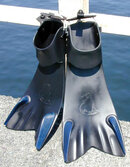
With all that being said, I still prefer steel 72's to Al 80's by a wide margin......I would be quite happy doing recreational dives( 90% of what I dive these days), with a j valve and a single reg ( which is easy to buddy breathe with for any dive buddy I would have), and I could pretty much be living in 1960's gear, all except for the fins.....When I was certified in 1972, I was always looking for the most powerful fins....this led me to the Farrah Fins with the ankle brace( because they were insanely stiff and long) as soon as they came out. These were pretty much Jet Fins on Anabolic Steroids AND Growth Hormones

In fact, the only time they would really flex, was when you were involved in a full tilt sprint

The rest of the time they were boards...long ones. At some point in the 80's I realized efficiency was a bigger issue, to accomplish many of the adventures we were after at the time....This was at a time when I was trying to get into structures and high current sites, or deep and fabled sites related in fisherman's stories, etc....to go "where no man had gone before"

So the need for a quantum jump in fin technology first pushed me to the Cressi Rondine Garas, when they came out, and this one area of dive gear technology, our ability to move ourselves around well underwater, to me should not be compromised by defective technology....the old steel 72's, the masks, the regs, the harness without BC, all this allowed you to do ANYTHING the 2014 advertised equivalent would do.....Not so with fins.






 .
.